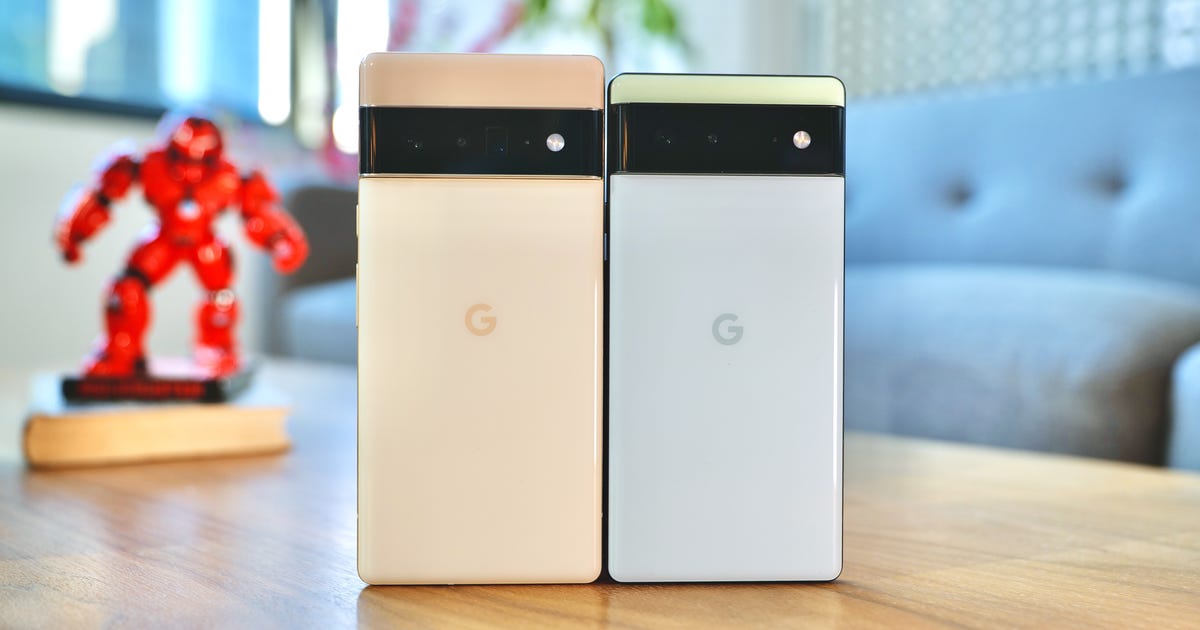The $599 Pixel 6 has new cameras and Google’s ambitious Tensor processor
The new Google Pixel 6 and Pixel 6 Pro showcase one of the biggest year-to-year phone upgrades I’ve seen in a long time. In the lead-up to Google’s fall Pixel event Tuesday, the company behind Android and YouTube did something many other phone-makers don’t and announced both new Pixel 6 phones back in August. The Pixel 6 has new camera hardware, runs on Google’s first in-house processor and has a design that looks unlike any other phone sold today.
The Pixel 6 series is an important release for Google because it’s a big shift away from the company’s pleasant midtier phone strategy of the past and a significant step toward a portfolio designed to compete with premium phones from Apple, Samsung and Huawei.
Thematically, Google has aimed to make the Pixel 6 work well for more people. Part of that means making the cameras work better for people with different skin tones and improving voice recognition to easily identify different speaking patterns and accents.
Of the two phones, the $599 (£599) Pixel 6 is the more affordable model. It’s priced to compete with the iPhone 13, the Samsung Galaxy S21 and other midtier Android phones such as the current Motorola Edge. For more information on the Pixel 6 Pro, check out my comparison below or read our first impressions of the Google Pixel 6 Pro by my colleague Andrew Hoyle. (Pricing for Australia hasn’t been announced, but the price in the UK, which has similar tax, converts roughly to AU$1,100.)
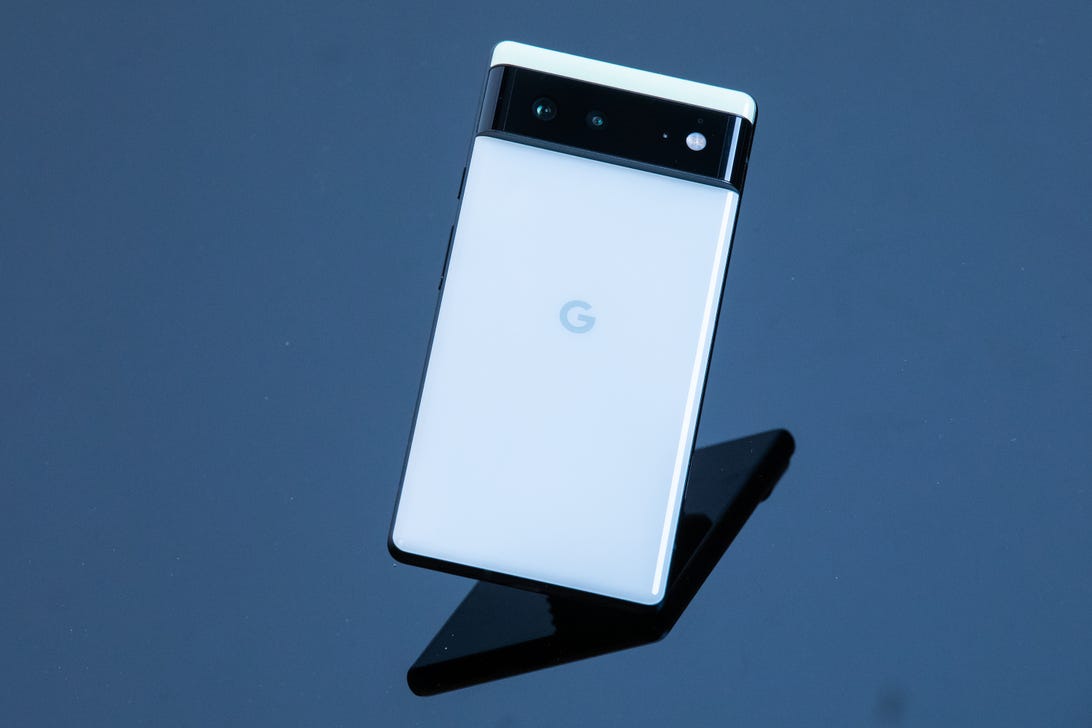
The Pixel 6 has one of the most eye-catching designs of 2021.
James Martin/CNET
The Pixel 6 design highlights its camera bump strip
Google used 100% recycled aluminum for the body of the Pixel 6. The sides have a matte finish and overall the Pixel 6 has an IP68 rating for water and dust resistance. The Pixel’s defining physical feature is its horizontal camera bump strip. It would be easy to say the camera strip was inspired by Robocop’s visor, or the visor on Cylons from Battlestar Galactica. But Google said it wanted to make a unique camera bump that celebrates the camera system. So instead of a square in the corner the designers went for a strip.
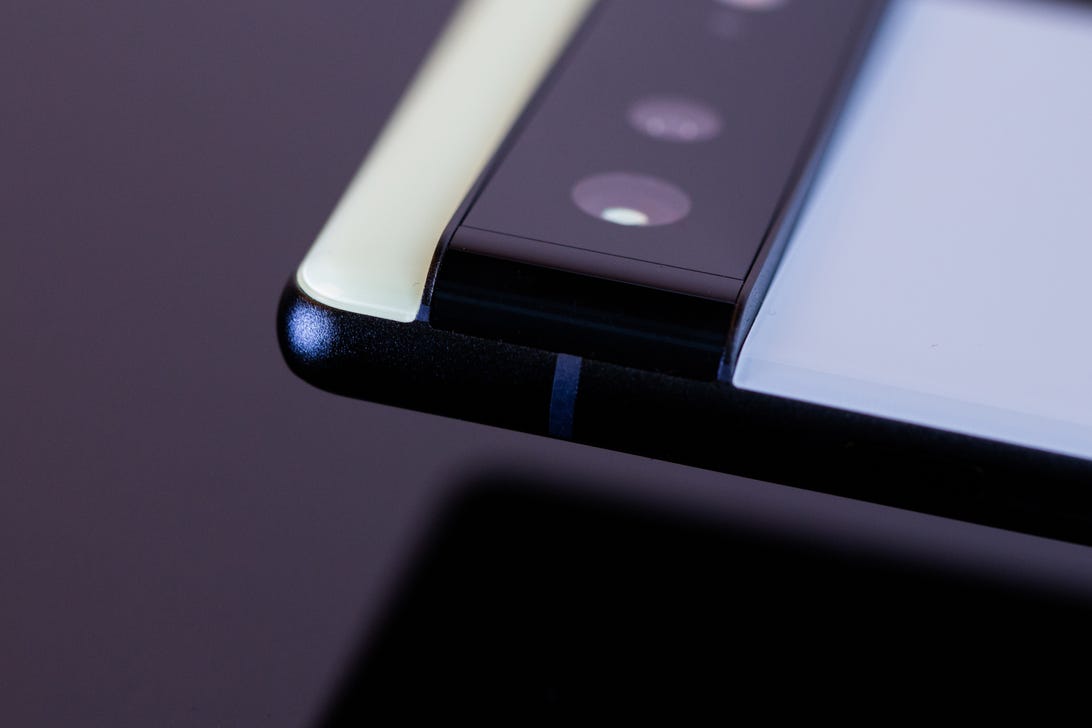
Instead of a square in the corner, the camera bump on the Pixel 6 runs horizontally across the back of the phone.
James Martin/CNET
In person it looks like a piece of a black mineral that has been cut, shaped and polished into a camera bump that keeps your phone level so it doesn’t wobble. The camera bump houses wide and ultrawide cameras (more on those in a moment).
On the front of the Pixel 6 is a 6.4-inch display covered in Gorilla Glass Victus with an under-display fingerprint reader. The screen has a 90Hz high refresh rate, which should make animations look smoother and feel more responsive.
Tensor defines the Google Pixel 6
The brains of the new Pixel don’t come from Qualcomm. Instead the phone’s powered by a brand-new chip called Tensor. It’s the first processor designed by Google and it’s been custom-made for the Pixel. Google said that it’s 80% faster than the Qualcomm Snapdragon 765G chip found in last year’s Pixel 5.
Google wanted to go farther with software and computations and hence created the Tensor chip. As much as the camera bump strip defines the design, Tensor defines the Pixel. It allows for on-device AI like faster, more accurate speech recognition and image processing.
I asked about the possibility of seeing a Tensor chip in another device and while Google declined to comment, the company did say that this was not a one-off.
Pixel 6 camera gets better at skin tones with Real Tone
The main camera on the Pixel 6 has a wide angle lens and a 50-megapixel sensor, which is the largest sensor ever in a Pixel camera. The camera uses pixel-binning to combine multiple pixels together to create a 12.5-megapixel photo. The results are brighter photos with better details and more accurate colors. Google claims the new main camera can capture 150% more light than the main camera on the Pixel 5.
There is a new ultrawide camera with a 12-megapixel sensor and a 114-degree field of view. Around the front is an 8-megapixel selfie camera.

These are three photos Google provided us with that were taken with the Pixel 6.
But if there’s one thing Google Pixel cameras are known for, it’s software and computational photography. Google designed the Pixel cameras and computations to be more accurate no matter your complexion with Real Tone. For the past 18 months Google has partnered with directors, photographers and cinematographers like DP Kira Kelly and colorist Alex Bickel, known for their beautiful depictions of communities of color. The idea was to improve the Pixel’s cameras and algorithms in two ways.
The first is detection. Google wanted the phone to be able to identify a face, no matter how light or dark someone’s skin is or how complex the lighting is. The second part is working with engineers to improve the aesthetics of how photos were rendered. When a subject has a darker complexion, the algorithm adds more nuance to midtones and undertones.
Android 12 and other notable software additions for the Pixel 6
The Pixel 6 runs Android 12, which offers more customization around preferences and aesthetics. Just as the Pixel 6 represents the biggest phone upgrade from Google in years, Android 12 marks the biggest OS update in years. Android 12 is packed with visual upgrades like customizable color palettes, bigger buttons and updated notifications.
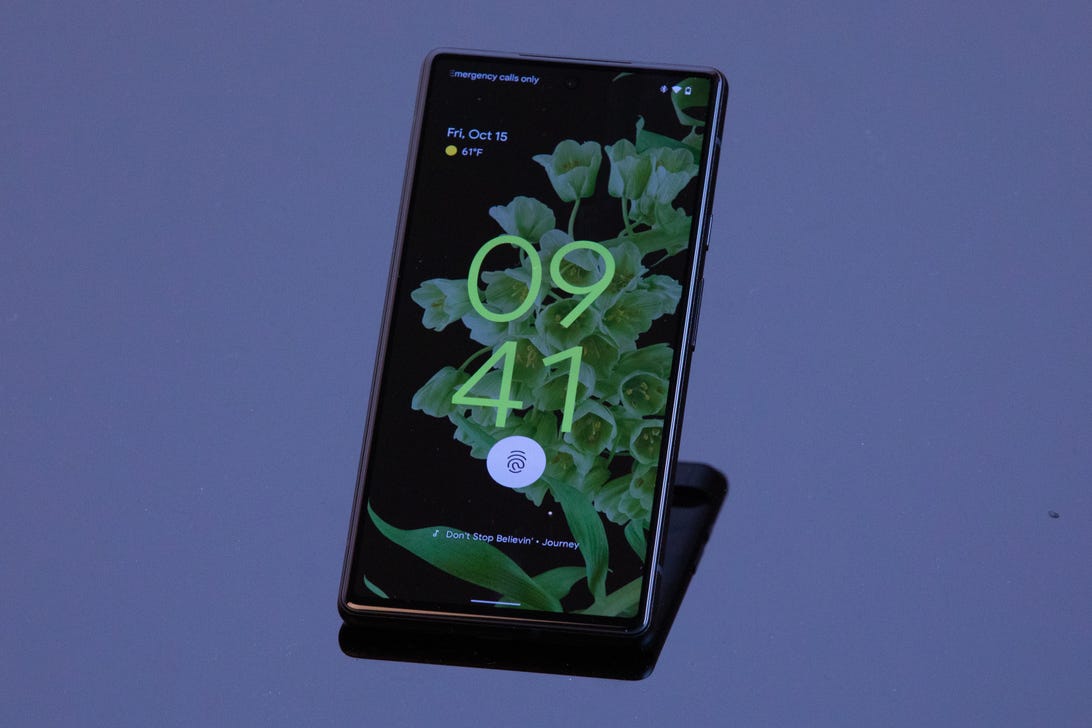
This is the Android 12 lock screen for the Pixel 6.
James Martin/CNET
And the Pixel 6 gets a bunch of new nifty software updates, notably Wait Time, which lets you know the best times to call a business so you won’t have a long wait. There’s also Direct My Call, which uses Google Assistant to work its way through the automated prompts of a call until it gets to an actual person.
In photos, there’s a new tool called Magic Eraser that lets you quickly remove unwanted things and people from your photos. RIP, all you photobombers. There’s also a Motion mode, which can create Action Pan photos where the background is blurred to mimic your subject moving quickly. Motion mode can also create Long Exposure photos that make running water look like silk and capture light trails from car traffic.
Read more: Google Pixel 6 vs. 6 Pro vs. Pixel 5 vs. 5A: What are the differences?
Pixel 6 vs. Pixel 6 Pro: All the differences
The two phones Google launched Tuesday are similar in a number of ways. But there are differences that set them apart and perhaps the largest difference is price. In the US, the Pixel 6 starts at $599 and the Pixel 6 Pro at $899.
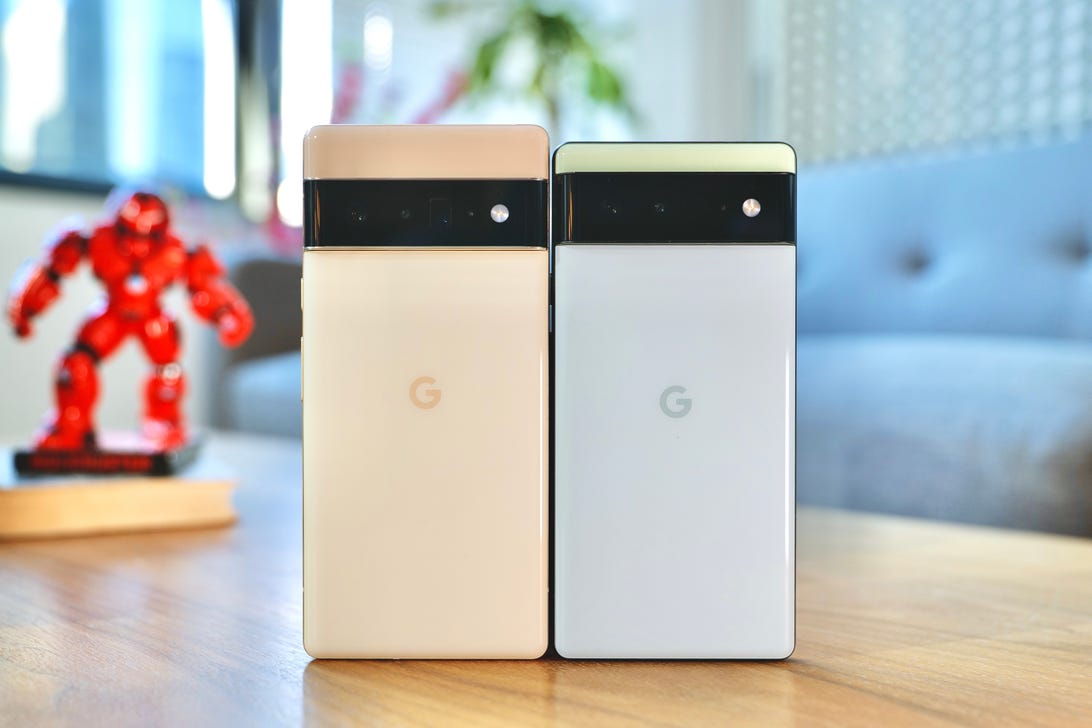
On the left is the Google Pixel 6 Pro and on the right the Pixel 6.
Patrick Holland/CNET
The screen on the Pixel 6 has a 6.4-inch, FHD Plus, high refresh-rate display that can switch between 90Hz and 60Hz. The Pixel 6 Pro has a larger 6.7-inch QHD LTPO (that’s low-temperature polycrystalline oxide) that can adapt the refresh rate between 10Hz and 120Hz. The display on the Pro curves over the sides of the phone.
In terms of cameras, the Pro has a 48-megapixel, 4x optical zoom telephoto camera. The Pixel 6 doesn’t. The Pixel 6 has an 8-megapixel front-facing camera with an 84-degree field of view that can record 1,080p video at 30 frames per second. The Pro has an 11-megapixel selfie camera with a wider 94-degree field of view that can record 4K 30fps videos.
Other differences:
- The back of the Pro has Gorilla Glass Victus and the Pixel 6 has Gorilla Glass 6.
- The Pixel 6 Pro has an ultrawideband chip and the Pixel 6 doesn’t.
- The Pixel 6 has a 4,614-mAh-capacity battery and the Pro has a 5,003-mAh one.
- The Pixel 6 Pro supports both sub-6 and mmWave 5G.
- The Pixel 6 supports sub-6 5G. A more expensive carrier version also supports mmWave.
The Pixel 6, 5G and battery life
The Pixel 6 supports sub-6 5G. Some carrier versions of the Pixel 6 will also support mmWave, which is the fast version of 5G that’s not widely available. Google says that battery life is a single day when using 5G. The Pixel 6 has a 4,614-mAh battery and supports 30-watt USB-C fast charging, but as with pretty much every other phone-maker, the fast-charger is sold separately.
Google Pixel Pass
Google promises to support the Pixel 6 and 6 Pro with five years of OS and software upgrades. The search giant also has a new subscription service called Pixel Pass that lets you buy the Pixel 6 and get phone protection, YouTube Premium, YouTube Music Premium, Google One and Google Play Pass for $45 a month over two years. You can get a Pixel pass for the Pixel 6 Pro for $55 a month.
Here’s everything to know about the Pixel 6 Pro and Google’s new Tensor chip. Plus, why Pixel phones are great alternatives to Apple and Samsung phones (and why the Pixel 6 is more exciting than the iPhone 13), and whether it’s still worth it to buy a Pixel 3, 4 or 5.
Google Pixel 6 specs vs. Google Pixel 6 Pro, Google Pixel 5, Apple iPhone 13
| Google Pixel 6 | Google Pixel 6 Pro | Google Pixel 5 | Apple iPhone 13 | |
|---|---|---|---|---|
| Display size, resolution | 6.4-inch OLED; 2,400×1,080 pixels; 60Hz or 90Hz | 6.7-inch LTPO OLED; 3,120×1,440 pixels; 10-120Hz | 6-inch FHD+ OLED; 2,340×1,080 pixels | 6.1-inch OLED; 2,532×1,170 pixels |
| Pixel density | 411 ppi | 512 ppi | 432 ppi | 460 ppi |
| Dimensions (inches) | 6.2×2.9×0.4 in | 6.5×3.0x0.4 in | 5.7×2.8×0.3 in | 5.78×2.82×0.3 in |
| Dimensions (millimeters) | 158.6×74.8×8.9mm | 163.9×75.9×8.9mm | 144.7×70.4x8mm | 147x72x7.65mm |
| Weight (ounces, grams) | 7.3 oz; 207g | 7.41 oz; 210g | 5.33 oz; 151g | 6.14 oz; 174g |
| Mobile software | Android 12 | Android 12 | Android 11 | iOS 15 |
| Camera | 50-megapixel (wide), 12-megapixel ultrawide | 50-megapixel (wide), 12-megapixel (ultrawide), 48-megapixel (telephoto) | 12.2-megapixel (standard), 16-megapixel (ultrawide) | 12-megapixel (wide), 12-megapixel (ultrawide) |
| Front-facing camera | 8-megapixel | 11-megapixel | 8-megapixel | 12-megapixel |
| Video capture | 4K 30, 60fps (rear), 1,080p 30fps (front) | 4K 30, 60fps (rear), 4K 30fps (front) | 4K | HDR video recording with Dolby Vision up to 4K at 60fps |
| Processor | Google Tensor | Google Tensor | Qualcomm Snapdragon 765G | Apple A15 Bionic |
| Storage | 128GB, 256GB | 128GB, 256GB, 512GB | 128GB | 128GB, 256GB, 512GB |
| RAM | 8GB | 12GB | 8GB | Undisclosed |
| Expandable storage | No | No | No | No |
| Battery | 4,614 mAh | 5,003 mAh | 4,000 mAh | Undisclosed; Apple lists 19 hours of video playback |
| Fingerprint sensor | Under display | Under display | Rear | No (Face ID) |
| Connector | USB-C | USB-C | USB-C | Lightning |
| Headphone jack | No | No | No | No |
| Special features | 5G sub 6 (some carrier models also have 5G mmWave) support, Wi-Fi 6E, 30W fast-charging, wireless charging, Magic Eraser, Motion mode, Real Tone, Face Unblur, Cinematic Pan, 5 years OS security updates, IP68 rating for dust and water resistance, Gorilla Glass Victus (front), Gorilla Glass 6 (back), dual-SIM capabilities (nano-SIM and e-SIM) | 5G sub 6 and mmWave support, Wi-Fi 6E, Ultrawideband, 30W fast-charging, wireless charging, Magic Eraser, Motion mode, Real Tone, Face Unblur, Cinematic Pan, 5 years OS security updates, IP68 rating for dust- and water-resistance, Gorilla Glass Victus (front and back), dual-SIM capabilities (nano-SIM and e-SIM) | 5G enabled; water-resistant (IP68); 90Hz-refresh-rate display; dual-SIM capabilities (nano-SIM and e-SIM); reverse wireless charging; fast charging | 5G enabled; MagSafe; water-resistant (IP68); wireless charging; dual-SIM capabilities (nano-SIM and e-SIM) |
| Price off-contract (USD) | $599 (128GB) | $899 (128GB) | $699 | $799 (128GB), $899 (256GB), $1,099 (512GB) |
| Price (GBP) | £599 (128GB) | £849 (128GB) | £599 | £779 (128GB), £879 (256GB), £1,079 (512GB) |
| Price (AUD) | Converts to AU$1,100 | Converts to AU$1,570 | AU$999 | AU$1,349 (128GB), AU$1,519 (256GB), AU$1,869 (512GB) |
For all the latest world News Click Here

